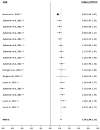Concussion recovery time among high school and collegiate athletes: a systematic review and meta-analysis
- PMID: 25820456
- PMCID: PMC4441834
- DOI: 10.1007/s40279-015-0325-8
Concussion recovery time among high school and collegiate athletes: a systematic review and meta-analysis
Abstract
Background: Concussion diagnosis and management is made through the clinical exam using assessment tools that include self-report symptomatology, postural control, and cognitive evaluations. The specific timing of concussion resolution varies between individuals. However, despite a lack of research in concussion recovery, it is widely accepted that the majority of young adults will recover in 7-10 days, with youth athletes taking longer.
Objectives: The purpose of this review is to directly compare the recovery duration among high school and collegiate athletes on symptom reports and cognitive assessments following concussion.
Data sources: Data were collected from a literature search comprising high school or college athletes only. This included studies (n = 6) that reported symptom or cognitive performance recovery to the exact day.
Results: High school athletes self-reported symptom recovery at 15 days compared with 6 days in collegiate athletes. Both college and high school athletes showed cognitive recovery at similar rates of 5 and 7 days.
Limitations: This review only included articles that were directly related to concussed high school or college athletes. Additionally, athletes in the high school and college setting typically receive a battery of neurocognitive tests that may not be as sensitive or as comprehensive as a full neuropsychological exam.
Conclusion: The review finds that neurocognitive recovery rates are similar among high school and college athletes, while symptom reporting shows longer recovery time points in high school than in college.
Implications of key findings: An individualized and stepwise concussion management plan is important for proper concussion recovery regardless of age.
Conflict of interest statement
Figures





Comment in
-
Systematic Review on Concussion Recovery Time Lacks Comprehensiveness.Sports Med. 2015 Sep;45(9):1355-1356. doi: 10.1007/s40279-015-0367-y. Sports Med. 2015. PMID: 26243015 No abstract available.
References
-
- McCrory P, Meeuwisse WH, Aubry M, Cantu B, Dvorak J, Echemendia RJ, et al. Consensus statement on concussion in sport—the 4th international conference on concussion in sport held in Zurich, November 2012. Br J Sports Med. 2013;47(5):250–8. - PubMed
-
- Langlois JA, Rutland-Brown W, Wald MM. The epidemiology and impact of traumatic brain injury: a brief overview. J Head Trauma Rehab. 2006;21(5):375–8. - PubMed
-
- Buzzini SR, Guskiewicz KM. Sports-related concussion in the young athlete. Curr Opin Pediatr. 2006;18:376–82. - PubMed
-
- Guskiewicz K, Weaver N, Padua D, Garrett W. Epidemiology of concussion in collegiate and high school football players. Am J Sport Med. 2000;28:643–50. - PubMed
-
- Guskiewicz K, McCrea M, Marshall S, Cantu R, Randolph C, Barr W. Cumulative effects associated with recurrent concussion in collegiate football players: The NCAA concussion study. J Am Med Assoc. 2003;290(19):2549–55. - PubMed
Publication types
MeSH terms
Grants and funding
LinkOut - more resources
Full Text Sources
Other Literature Sources
Medical
Research Materials

